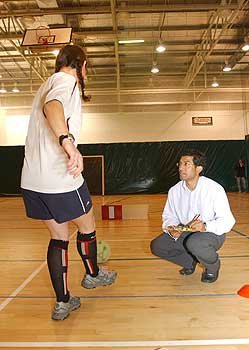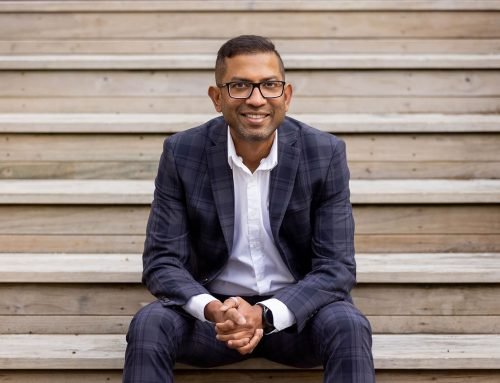
Dr Ajmol Ali conducting research.
Click here to view the article on the Massey University site (29/10/2013)
The size of the problem
New Zealand is currently ranked third in the OECD with 26.5 per cent of the adult population deemed obese. But the worrying trend is that, at 28.5 per cent, the percentage of New Zealand children aged two to 14 years in the obese category is even higher. And Pacific and Māori children are 2.5 and 1.5 times more likely to become obese relative to children in the overall population.
Meanwhile, it is estimated that 4.5 per cent of the total health care budget – $686 million – is spent on overcoming obesity, and an additional $225 million of lost productivity has been associated with the problem.
Childhood obesity has been linked with poor academic performance, physical and mental illness, reduced self-esteem and quality of life, and greatly increases the likelihood of becoming obese as an adult. As the average age of New Zealand’s population increases it will be imperative that our workforce, the children of today, are as healthy as possible.
Over the past 30 years adult obesity has increased by 17.5 per cent. While the rate of increase has slowed in recent national surveys, New Zealand could still be looking at close to half its adult population classified as obese in another 30 years, nearly tripling the cost to our economy.
So, what can be done? Is this a health problem that New Zealand can overcome within the next generation? To reduce this burden as individuals, and collectively as a nation, we need to get our young people moving more.
A simple exercise plan
Reduce inactivity. A growing research area is looking at ways in which to reduce physical inactivity in children. If periods of inactivity can be minimised then children will seek more physically active pursuits. This means less ‘screen time’ (television, computer and smartphone use), which has been associated with long-lasting adverse effects such as raised cholesterol, smoking, and being overweight, and greater access to play areas and equipment when the television is turned off.
Improve motor skills from an early age. Pre-school children with better motor skills – the ability to jump, climb up and down safely, throw and catch a ball – have enhanced physical activity levels into adolescence. These seem to be very simple activities but are important for long-term development. Research has shown that learning these motor skills positively affects academic and cognitive ability as well. We need to make learning fun for toddlers and young children through music and dance, visual stimuli and group play – and we need to make such classes available to all.
Market exercise better. Most New Zealand children do not meet the recommended 60 minutes of moderate-to-vigorous physical activity per day. Regimented activities such as playing competitive sport are often put in the ‘too-hard’ basket so exercise practitioners need to refocus their marketing efforts to highlight the importance of ‘bite-sized’ units of exercise accumulated throughout the day. Small-scale lifestyle adjustments seem more achievable to people than wholesale changes, and immediate benefits like ‘feeling good’ may be more motivating than future benefits like ‘better health’.
Get parents involved. A parent’s level of activity, as well as their BMI, has been associated with the physical activity and body mass of their child so parental interaction is vital. Parents must be taught how to interact with their child and learn ways in which to manage risk. Forty per cent of pre-school aged children are now in childcare so it is important that parents find the time to play with their child and teach them vital life skills.
Embrace technology. It is convenient to blame entertainment technology for reducing physical activity levels. A more pragmatic approach is to work with the best of the digital age to enhance physical literacy and activity levels. Gaming consoles like Wii and dance platforms that are more physically demanding are great examples of this. Exercise practitioners need to think more creatively and interact with children in more savvy ways.
The big picture
Kicking childhood obesity to touch requires political will and leadership. Our government will need to focus more on preventative, as opposed to reactive, measures to combat the problem, and there needs to be better coordination between health and education agencies.
New Zealand has an excellent schooling system and rightly focuses on core academic disciplines. But the issue of physical literacy needs equal status if New Zealand children are to become healthier and less obese. Toddlers and pre-schoolers require physical activity classes, from trained staff using specialised equipment.
We could learn a lot from Finland, which has been at the top of OECD academic student assessments since 2000. Children there do not start comprehensive school until they are seven. Before that, the state-funded education system focuses on learning through play and teachers are trained to help children learn through physical activity. Finland also has higher tax rates to pay for these services.
New Zealand needs to decide whether reducing childhood obesity rates is something it’s willing to invest in – and we need long-term planning from our political leaders, not short-term interventions. But if people feel strongly enough about these issues, then change is possible.
Dr Ajmol Ali is a Senior Lecturer in Massey University’s School of Sport and Exercise.








